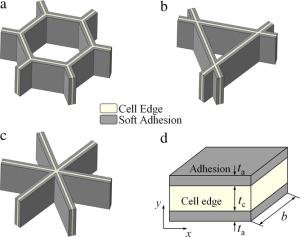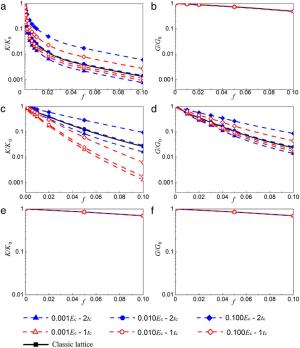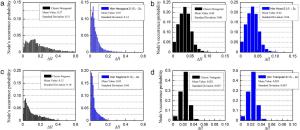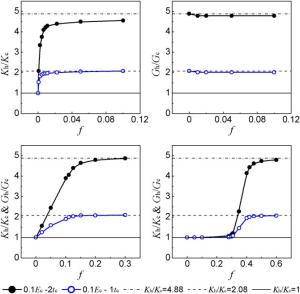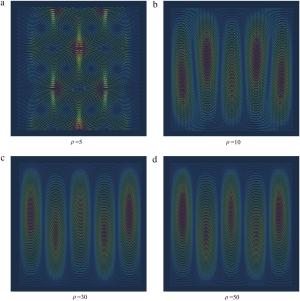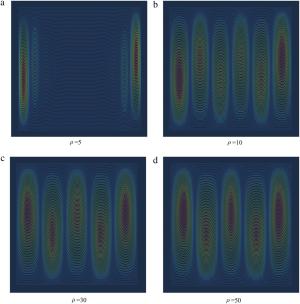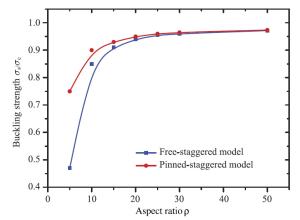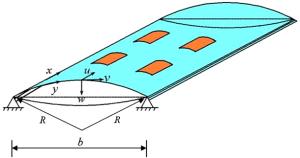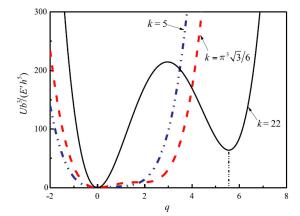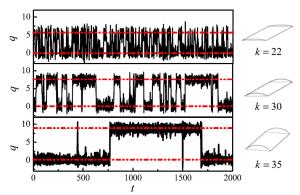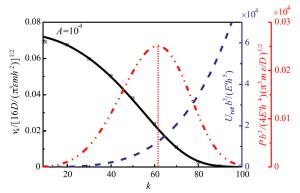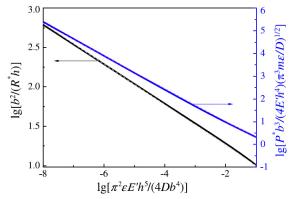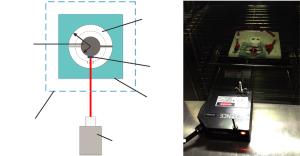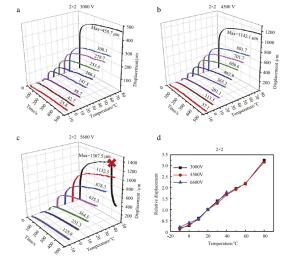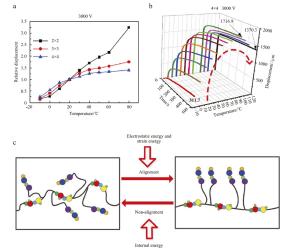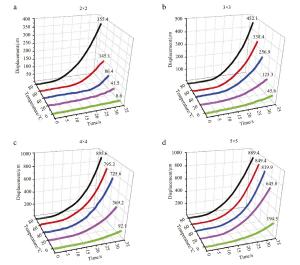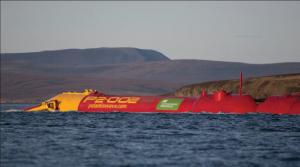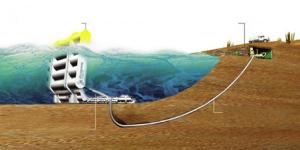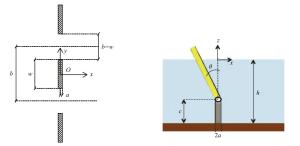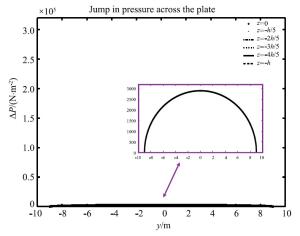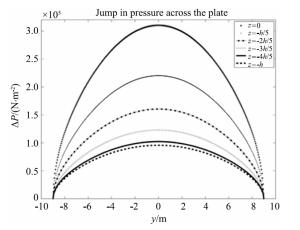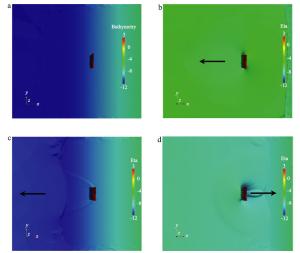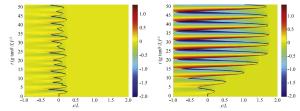Institute of Mechanics,
Chinese Academy of Sciences
2015 Vol.5(4)
Display Mode: |
Theoretical and Applied Mechanics Letters 2015, 5(4): 141-145.
doi: 10.1016/j.taml.2015.05.004
Abstract:
Commercially available lattices contain various kinds of morphological imperfections which result in great degradation in lattices' mechanical properties, therefore, to obtain imperfection insensitive lattice structure is obviously a practical research subject. Hierarchical structure materials were found to be a class of promising anti-defect materials. This paper builds hierarchical lattice by adding soft adhesion to lattice's cell edges and numerical results show that its imperfection sensitivity to missing bars is minor compared with the classic lattice. Soft adhesion with appropriate properties reinforce cell edge's bending stiffness and thus reduce the bending deformation in lattice caused by missing bars defect, which is confirmed by statistical analysis of normalized node displacements of imperfect lattices under hydrostatic compression and shear loads.
Commercially available lattices contain various kinds of morphological imperfections which result in great degradation in lattices' mechanical properties, therefore, to obtain imperfection insensitive lattice structure is obviously a practical research subject. Hierarchical structure materials were found to be a class of promising anti-defect materials. This paper builds hierarchical lattice by adding soft adhesion to lattice's cell edges and numerical results show that its imperfection sensitivity to missing bars is minor compared with the classic lattice. Soft adhesion with appropriate properties reinforce cell edge's bending stiffness and thus reduce the bending deformation in lattice caused by missing bars defect, which is confirmed by statistical analysis of normalized node displacements of imperfect lattices under hydrostatic compression and shear loads.
Theoretical and Applied Mechanics Letters 2015, 5(4): 146-150.
doi: 10.1016/j.taml.2015.05.006
Abstract:
Biological materials such as bone, tooth, and nacre are load-bearing nanocomposites composed of mineral and protein. Since the mineral crystals often have slender geometry, the nanocomposites are susceptible to buckle under the compressive load. In this paper, we analyze the local buckling behaviors of the nanocomposite structure of the biological materials using a beam-spring model by which we can consider plenty of mineral crystals and their interaction in our analysis compared with existing studies. We show that there is a transition of the buckling behaviors from a local buckling mode to a global one when we continuously increase the aspect ratio of mineral, leading to an increase of the buckling strength which levels off to the strength of the composites reinforced with continuous crystals. We find that the contact condition at the mineral tips has a striking effect on the local buckling mode at small aspect ratio, but the effect diminishes when the aspect ratio is large. Our analyses also show that the staggered arrangement of mineral plays a central role in the stability of the biological nanocomposites.
Biological materials such as bone, tooth, and nacre are load-bearing nanocomposites composed of mineral and protein. Since the mineral crystals often have slender geometry, the nanocomposites are susceptible to buckle under the compressive load. In this paper, we analyze the local buckling behaviors of the nanocomposite structure of the biological materials using a beam-spring model by which we can consider plenty of mineral crystals and their interaction in our analysis compared with existing studies. We show that there is a transition of the buckling behaviors from a local buckling mode to a global one when we continuously increase the aspect ratio of mineral, leading to an increase of the buckling strength which levels off to the strength of the composites reinforced with continuous crystals. We find that the contact condition at the mineral tips has a striking effect on the local buckling mode at small aspect ratio, but the effect diminishes when the aspect ratio is large. Our analyses also show that the staggered arrangement of mineral plays a central role in the stability of the biological nanocomposites.
Theoretical and Applied Mechanics Letters 2015, 5(4): 151-154.
doi: 10.1016/j.taml.2015.05.003
Abstract:
The shallow cylindrical structure is suitable to develop broadband vibration energy harvesters due to the property of the inherent mechanical bistability. In this letter, the optimum design of the bistable cylindrical shell for broadband energy harvesting application is investigated from the structural point of view. The output power is evaluated by the concept of the harvestable power, which balances the frequency of snap through and the referred output energy associated with each snap through. The nondimensional harvestable power is analytically expressed as the function of the non-dimensional curvature parameter and one constructed parameter. The universal dependence of the optimal curvature parameter and the associated optimal harvestable power on the constructed parameter is derived, which can be well approximated by the linear relation in double logarithmic coordinate.
The shallow cylindrical structure is suitable to develop broadband vibration energy harvesters due to the property of the inherent mechanical bistability. In this letter, the optimum design of the bistable cylindrical shell for broadband energy harvesting application is investigated from the structural point of view. The output power is evaluated by the concept of the harvestable power, which balances the frequency of snap through and the referred output energy associated with each snap through. The nondimensional harvestable power is analytically expressed as the function of the non-dimensional curvature parameter and one constructed parameter. The universal dependence of the optimal curvature parameter and the associated optimal harvestable power on the constructed parameter is derived, which can be well approximated by the linear relation in double logarithmic coordinate.
Theoretical and Applied Mechanics Letters 2015, 5(4): 155-159.
doi: 10.1016/j.taml.2015.05.007
Abstract:
Under an applied voltage, dielectric elastomers (DEs) produce an actuation strain that is nonlinear, partly because of the material properties. In this study, an experimental characterization is conducted to evaluate how the ambient temperature and pre-stretch affected the actuation performance. For DEs with a pre-stretch of 2 × 2, an increase of temperature from -10° to 80° results in a variation in the actuation strain of more than 1700%. Low pre-stretched DEs are more susceptible to temperature change; while highly pre-stretched DEs are relatively insensitive to temperature, because in this case the energy conversion was dominated by mechanical stretching, rather than thermal conduction, during the actuation.
Under an applied voltage, dielectric elastomers (DEs) produce an actuation strain that is nonlinear, partly because of the material properties. In this study, an experimental characterization is conducted to evaluate how the ambient temperature and pre-stretch affected the actuation performance. For DEs with a pre-stretch of 2 × 2, an increase of temperature from -10° to 80° results in a variation in the actuation strain of more than 1700%. Low pre-stretched DEs are more susceptible to temperature change; while highly pre-stretched DEs are relatively insensitive to temperature, because in this case the energy conversion was dominated by mechanical stretching, rather than thermal conduction, during the actuation.
Theoretical and Applied Mechanics Letters 2015, 5(4): 160-166.
doi: 10.1016/j.taml.2015.05.008
Abstract:
With an increasing emphasis on renewable energy resources, wave power technology is becoming one of the realistic solutions. However, the 2011 tsunami in Japan was a harsh reminder of the ferocity of the ocean. It is known that tsunamis are nearly undetectable in the open ocean but as the wave approaches the shore its energy is compressed, creating large destructive waves. The question posed here is whether an oscillating wave surge converter (OWSC) could withstand the force of an incoming tsunami. Several tools are used to provide an answer: an analytical 3D model developed within the framework of linear theory, a numerical model based on the non-linear shallow water equations and empirical formulas. Numerical results show that run-up and draw-down can be amplified under some circumstances, leading to anOWSC lying on dry ground!
With an increasing emphasis on renewable energy resources, wave power technology is becoming one of the realistic solutions. However, the 2011 tsunami in Japan was a harsh reminder of the ferocity of the ocean. It is known that tsunamis are nearly undetectable in the open ocean but as the wave approaches the shore its energy is compressed, creating large destructive waves. The question posed here is whether an oscillating wave surge converter (OWSC) could withstand the force of an incoming tsunami. Several tools are used to provide an answer: an analytical 3D model developed within the framework of linear theory, a numerical model based on the non-linear shallow water equations and empirical formulas. Numerical results show that run-up and draw-down can be amplified under some circumstances, leading to anOWSC lying on dry ground!
 Submit a Paper
Submit a Paper
 Subscription
Subscription
News
MORE+
Call for Papers
MORE+
- Crossing-Mechanics Driven by Big Data
- Machine learning in the fluid mechanics research of wind energy
- Mechanics of Origami/Kirigami structures and metamaterials
- New insights and perspectives on impact biomechanics for human tissues: from injury prevention, protection to protective equipment
- Environmental Mechanics for Extreme Natural Events



